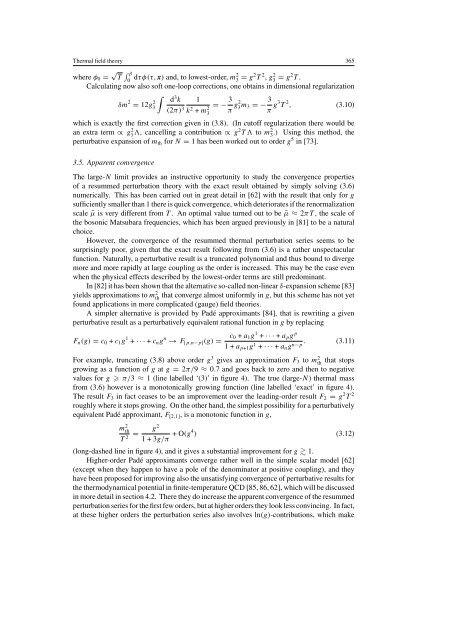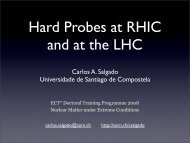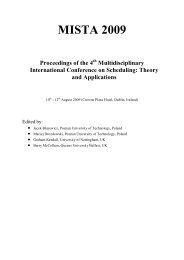Advances in perturbative thermal field theory - Ultra-relativistic ...
Advances in perturbative thermal field theory - Ultra-relativistic ...
Advances in perturbative thermal field theory - Ultra-relativistic ...
Create successful ePaper yourself
Turn your PDF publications into a flip-book with our unique Google optimized e-Paper software.
Thermal <strong>field</strong> <strong>theory</strong> 365<br />
where φ 0 = √ T ∫ β<br />
0 dτφ(τ, x) and, to lowest-order, m2 3 = g2 T 2 , g3 2 = g2 T .<br />
Calculat<strong>in</strong>g now also soft one-loop corrections, one obta<strong>in</strong>s <strong>in</strong> dimensional regularization<br />
∫<br />
δm 2 = 12g3<br />
2 d 3 k 1<br />
(2π) 3 k 2 + m 2 =− 3<br />
3<br />
π g2 3 m 3 =− 3 π g3 T 2 , (3.10)<br />
which is exactly the first correction given <strong>in</strong> (3.8). (In cutoff regularization there would be<br />
an extra term ∝ g3 2, cancell<strong>in</strong>g a contribution ∝ g2 T to m 2 3<br />
.) Us<strong>in</strong>g this method, the<br />
<strong>perturbative</strong> expansion of m th for N = 1 has been worked out to order g 5 <strong>in</strong> [73].<br />
3.5. Apparent convergence<br />
The large-N limit provides an <strong>in</strong>structive opportunity to study the convergence properties<br />
of a resummed perturbation <strong>theory</strong> with the exact result obta<strong>in</strong>ed by simply solv<strong>in</strong>g (3.6)<br />
numerically. This has been carried out <strong>in</strong> great detail <strong>in</strong> [62] with the result that only for g<br />
sufficiently smaller than 1 there is quick convergence, which deteriorates if the renormalization<br />
scale ¯µ is very different from T . An optimal value turned out to be ¯µ ≈ 2πT, the scale of<br />
the bosonic Matsubara frequencies, which has been argued previously <strong>in</strong> [81] to be a natural<br />
choice.<br />
However, the convergence of the resummed <strong>thermal</strong> perturbation series seems to be<br />
surpris<strong>in</strong>gly poor, given that the exact result follow<strong>in</strong>g from (3.6) is a rather unspectacular<br />
function. Naturally, a <strong>perturbative</strong> result is a truncated polynomial and thus bound to diverge<br />
more and more rapidly at large coupl<strong>in</strong>g as the order is <strong>in</strong>creased. This may be the case even<br />
when the physical effects described by the lowest-order terms are still predom<strong>in</strong>ant.<br />
In [82] it has been shown that the alternative so-called non-l<strong>in</strong>ear δ-expansion scheme [83]<br />
yields approximations to m 2 th<br />
that converge almost uniformly <strong>in</strong> g, but this scheme has not yet<br />
found applications <strong>in</strong> more complicated (gauge) <strong>field</strong> theories.<br />
A simpler alternative is provided by Padé approximants [84], that is rewrit<strong>in</strong>g a given<br />
<strong>perturbative</strong> result as a <strong>perturbative</strong>ly equivalent rational function <strong>in</strong> g by replac<strong>in</strong>g<br />
F n (g) = c 0 + c 1 g 1 + ···+ c n g n → F [p,n−p] (g) =<br />
c 0 + a 1 g 1 + ···+ a p g p<br />
. (3.11)<br />
1+a p+1 g 1 + ···+ a n gn−p For example, truncat<strong>in</strong>g (3.8) above order g 3 gives an approximation F 3 to m 2 th<br />
that stops<br />
grow<strong>in</strong>g as a function of g at g = 2π/9 ≈ 0.7 and goes back to zero and then to negative<br />
values for g π/3 ≈ 1 (l<strong>in</strong>e labelled ‘(3)’ <strong>in</strong> figure 4). The true (large-N) <strong>thermal</strong> mass<br />
from (3.6) however is a monotonically grow<strong>in</strong>g function (l<strong>in</strong>e labelled ‘exact’ <strong>in</strong> figure 4).<br />
The result F 3 <strong>in</strong> fact ceases to be an improvement over the lead<strong>in</strong>g-order result F 2 = g 2 T 2<br />
roughly where it stops grow<strong>in</strong>g. On the other hand, the simplest possibility for a <strong>perturbative</strong>ly<br />
equivalent Padé approximant, F [2,1] , is a monotonic function <strong>in</strong> g,<br />
m 2 th<br />
T = g 2<br />
2 1+3g/π +O(g4 ) (3.12)<br />
(long-dashed l<strong>in</strong>e <strong>in</strong> figure 4), and it gives a substantial improvement for g 1.<br />
Higher-order Padé approximants converge rather well <strong>in</strong> the simple scalar model [62]<br />
(except when they happen to have a pole of the denom<strong>in</strong>ator at positive coupl<strong>in</strong>g), and they<br />
have been proposed for improv<strong>in</strong>g also the unsatisfy<strong>in</strong>g convergence of <strong>perturbative</strong> results for<br />
the thermodynamical potential <strong>in</strong> f<strong>in</strong>ite-temperature QCD [85, 86, 62], which will be discussed<br />
<strong>in</strong> more detail <strong>in</strong> section 4.2. There they do <strong>in</strong>crease the apparent convergence of the resummed<br />
perturbation series for the first few orders, but at higher orders they look less conv<strong>in</strong>c<strong>in</strong>g. In fact,<br />
at these higher orders the perturbation series also <strong>in</strong>volves ln(g)-contributions, which make







